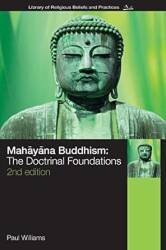
Ryokan Meals
Meals at my Ryokan at Mount Haguro
Booking aryokan
The meals were wonderful, as were all the other aspects
of my stay at the Tamonkan ryokan.
Kaiseki
or kaiseki-ryōri
is a traditional multi-course dinner.
The preparation and presentation are both important.
Kaiseki is a meal for Emperors,
priests and monks, and samurai.
It's based on Imperial court cuisine from the 9th century
before the court moved from Nara to Kyōto,
shōjin ryōri or
the cuisine of Buddhist temples and monasteries,
and honzen ryōri of samurai households.
The meal consists of several small dishes
incorporating fresh local ingredients.
Each is served in its own small dish or bowl or cup.
A bentō box meal is,
in some sense, a simple low-cost kaiseki
meal that you can buy at the train station,
something I consider a requirement for a Shinkansen trip.
However, bentō is kaiseki
in only a very limited sense!
As you will see below...
I had reserved my room through
Booking.com
and had selected the breakfast-and-dinner option then.
My host verified that when I arrived,
and asked then if I was vegetarian
or if I also ate seafood and egg dishes.
Yes, with seafood and eggs, please!
I'm sure that if I had demanded a vegan menu,
they could have handled that.
Although my host probably didn't speak Esperanto,
which strict veganism insists upon.
Dinner on Arrival Day
Yes, of course I'm wearing the yukata or casual lounging kimono the ryokan provides for guests. After my return I purchased my own.
I'm in pajama pants and T-shirt with the yukata over that, tied with the obi or sash. You wrap it with the left side over the right and tie it with the obi or sash.
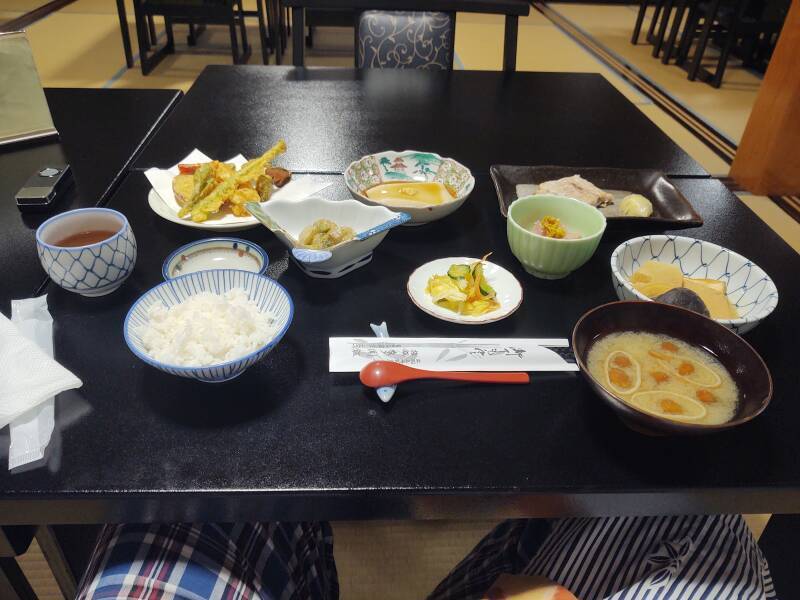
महायान` or Māhāyana is the largest branch of Buddhism, having developed in India in the first century BCE and spread north, east, and southeast from there. Several of its canonical scriptures prohibit eating meat, such as the Śūraṅgama Sūtra and Laṅkāvatāra Sūtra. Māhāyana Buddhism is the dominant branch in Japan. Its vegetarian cuisine is based on the Dharma concept of ahimsa or non-violence toward all living beings.
Nowadays it's mostly the monastic community that maintains a strict vegetarian diet, along with avoiding strong-smelling plants such as garlic, onion, and leek, as they are thought to excite the senses.
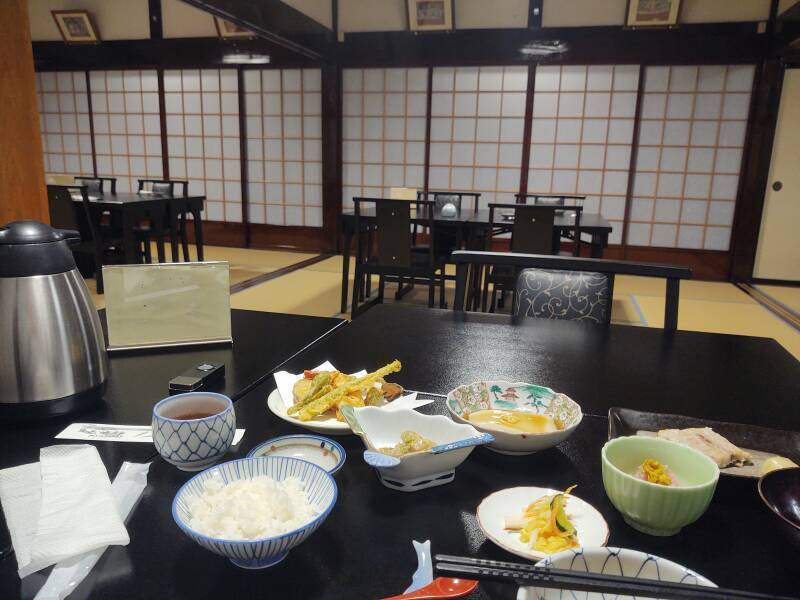
Miso or みそ is a paste made by fermenting soybeans with salt and kōji, the fungus Aspergillus oryzae, and possibly other ingredients. The kōji mold has been described as the "national fungus of Japan" due to its crucial role in producing miso, soy sauce, and other traditional foods, plus alcoholic beverages such as sake and shōchū.
Miso soup combines the miso paste with a stock containing kombu or edible kelp with thin flakes of fermented katsuo or skipjack tuna. This bowl also has small brown-capped mushrooms and slices of a much larger mushroom.

This dish combines sliced bamboo with a shiitake mushroom.
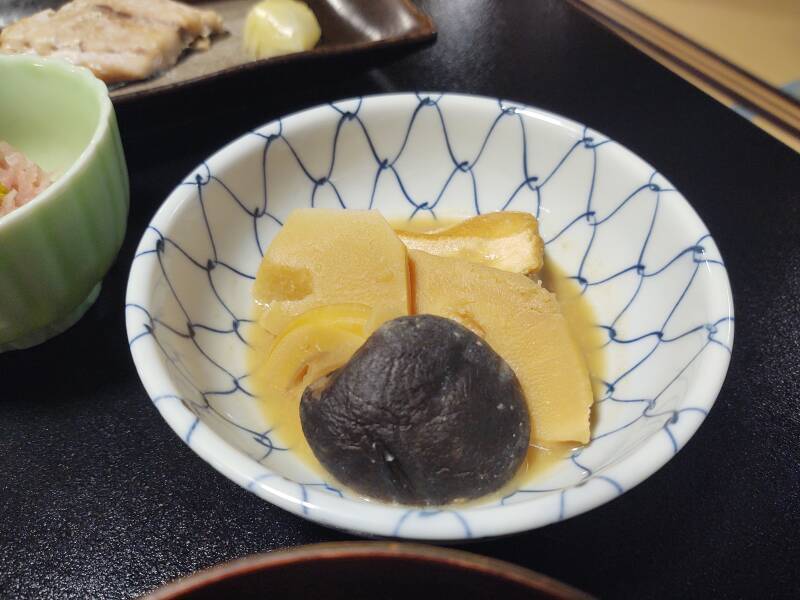
However, I'm neither a botanist nor a mycologist, and I'm at a loss to fully explain what most of the remaining pictures depict.
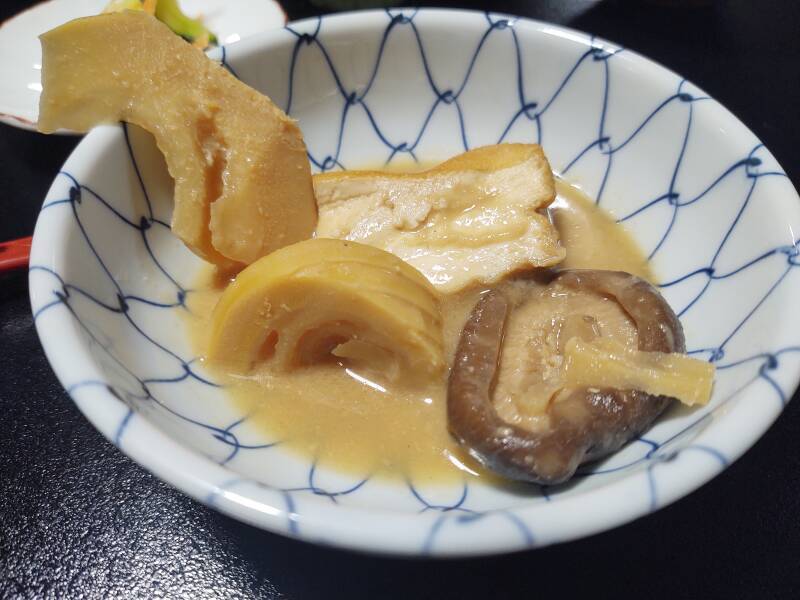
Japanese cuisine contains many products of fermentation, such as these pickled vegetables.
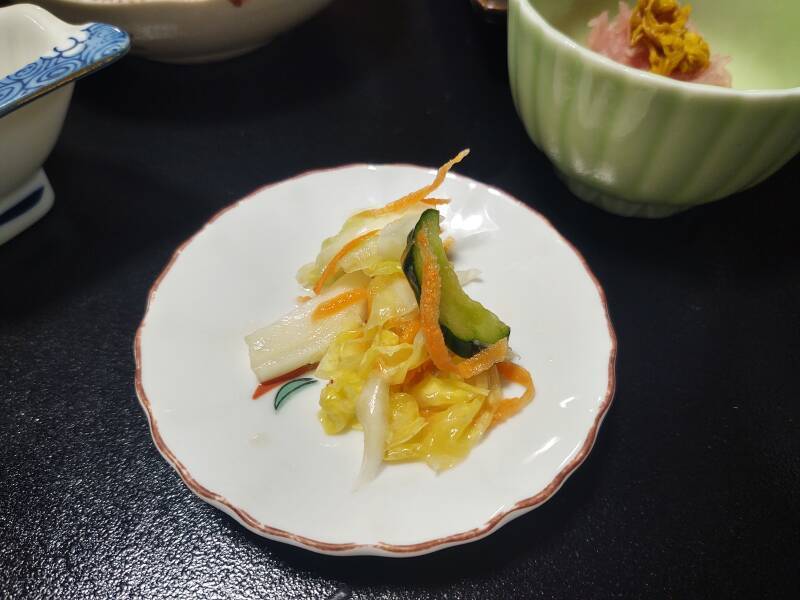
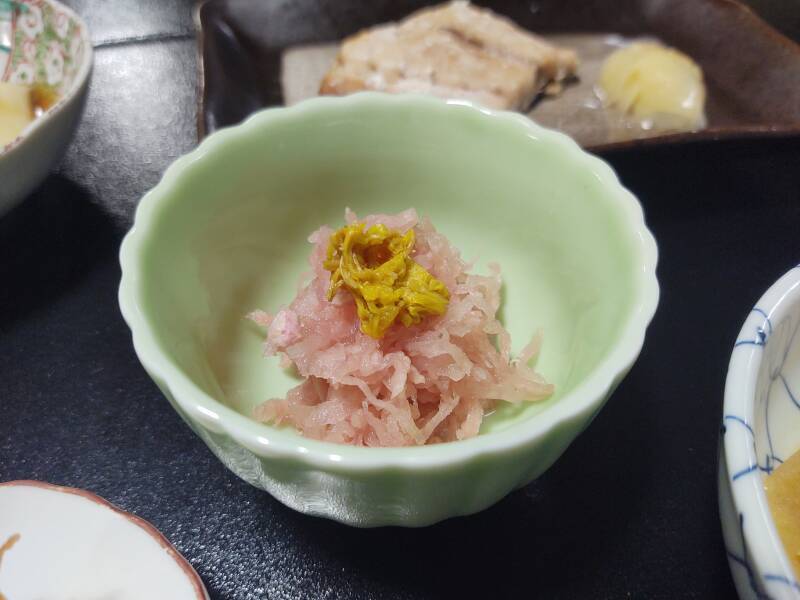
Tempura is a technique of deep-frying vegetables and seafood in a thin light batter.

Grilled fish, of course, with thinly sliced pickled ginger.


Of course a meal will be accompanied by rice.
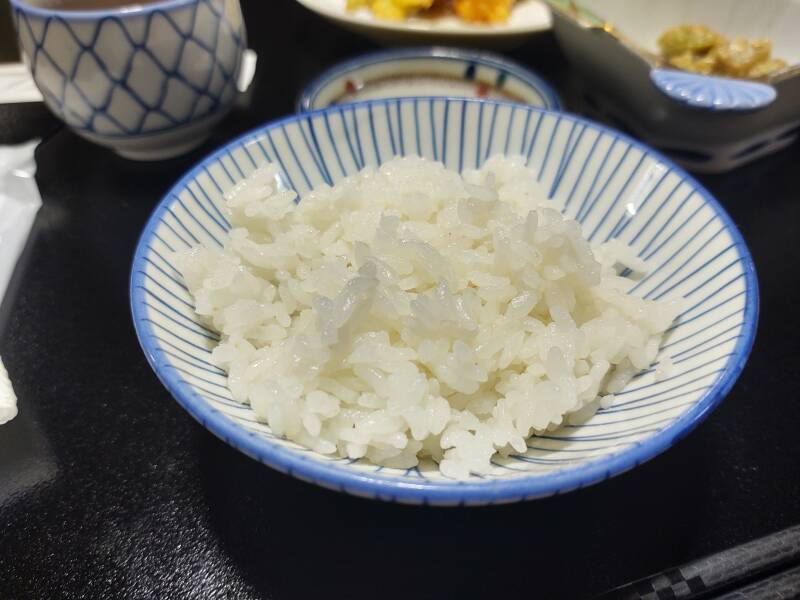
Dessert resembled flan, I believe this was tofu with honey.
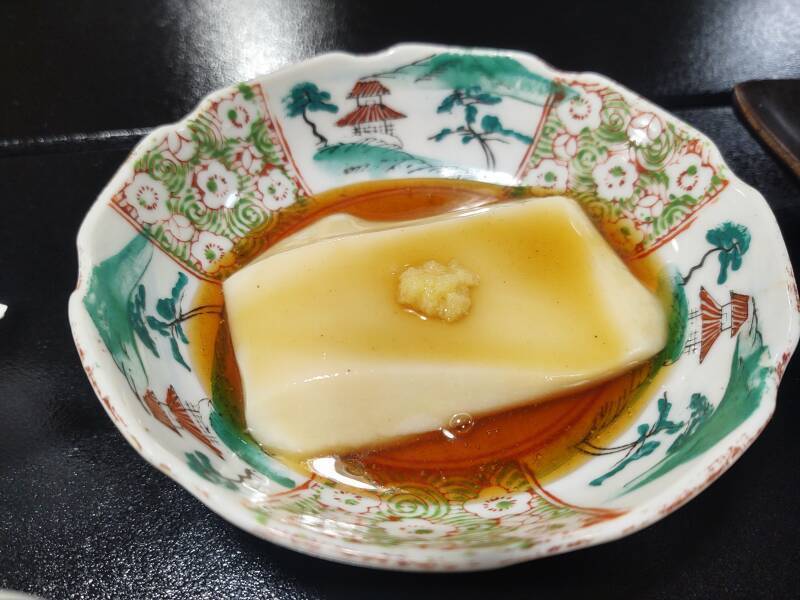
Breakfast on Day Two
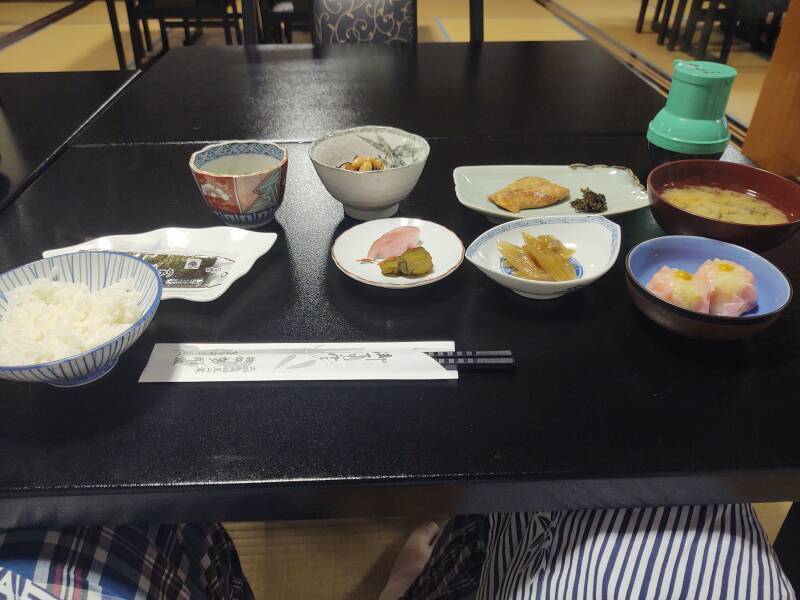
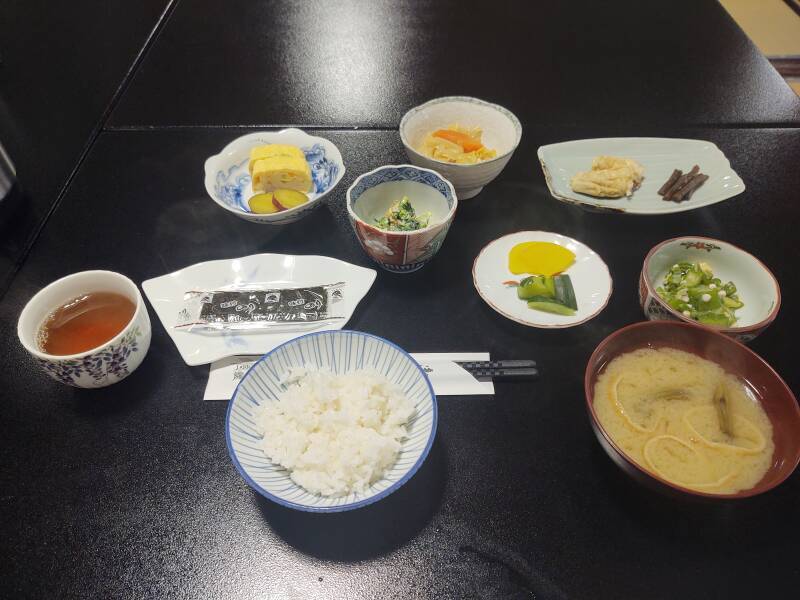
Bamboo was featured in several dishes, such as the steamed shoots with sesame seeds at left.
At right are two fish cakes.

Pickled vegetables, miso soup.
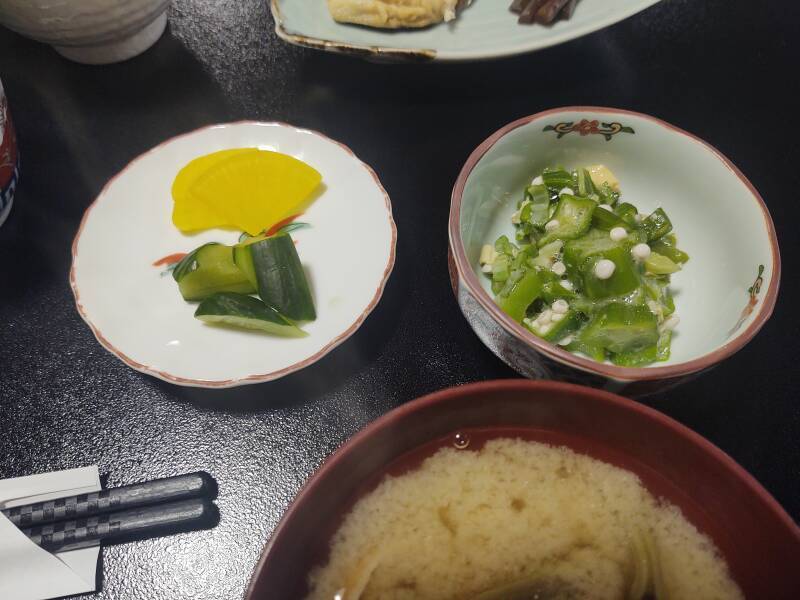
Grilled fish and bamboo shoots.

Pickled vegetables.
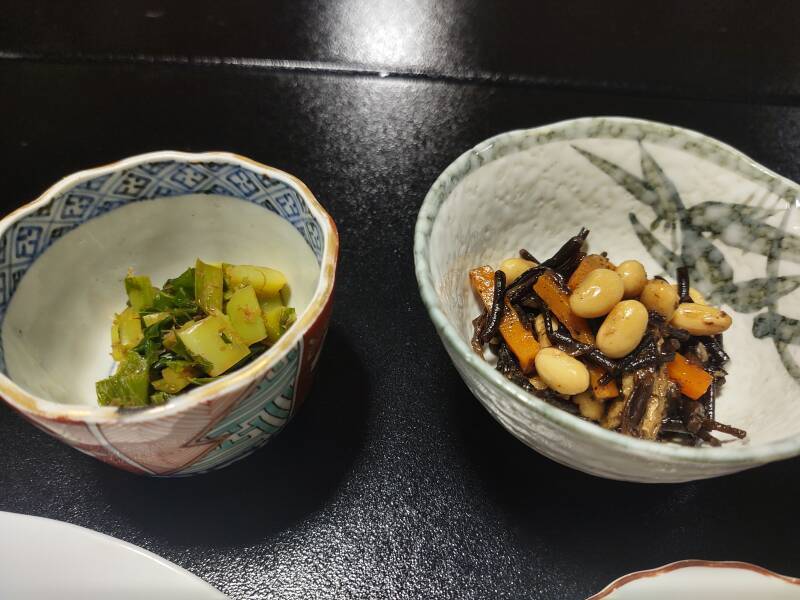
The dish at left has an omelet, it and the others have pickled vegetables.
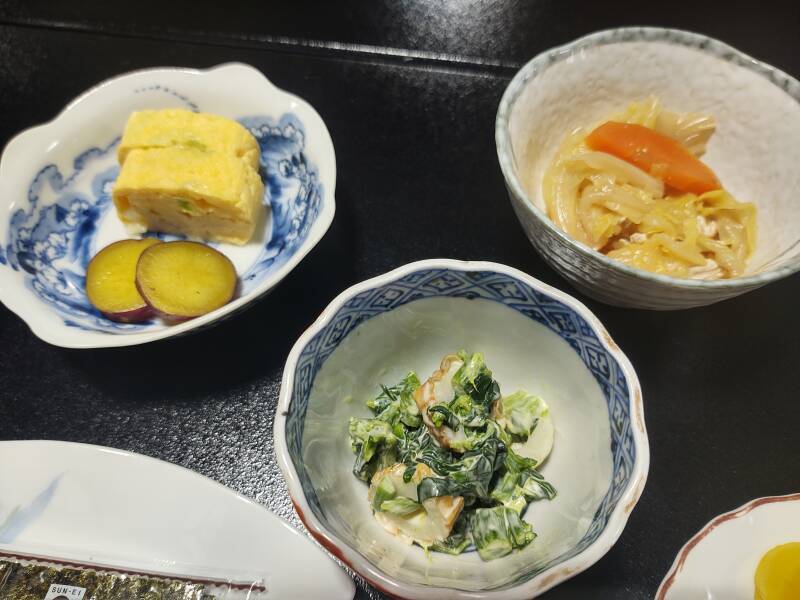
At left are nori sheets, dried Pyropia red algae. It's used to wrap sushi and onigiri or rice balls, and it can also be a snack or side dish. And at right, more pickles.

And, of course, rice and hot tea.
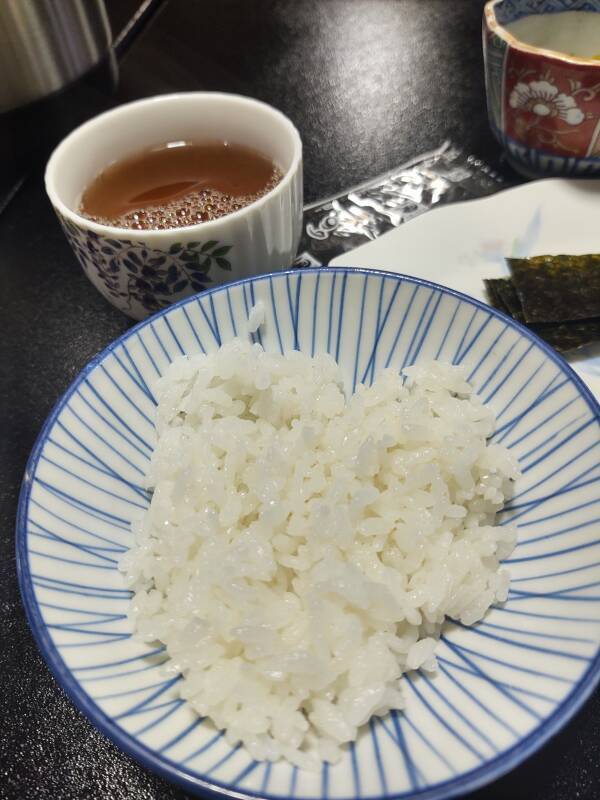
Dinner on Day Two
Dōgen Zenji, also known as Dōgen Kigen, founded the Sōtō school of Zen Buddhism in Japan. He wrote an influential essay titled Tenzo Kyōkun or "Instructions for the Cook". It contains:
In preparing food, it is essential to be sincere and to respect each ingredient regardless of how coarse or fine it is. [...] A rich buttery soup is not better as such than a broth of wild herbs. In handling and preparing wild herbs, do so as you would the ingredients for a rich feast, wholeheartedly, sincerely, clearly. When you serve the monastic assembly, they and you should taste only the flavour of the Ocean of Reality, the Ocean of unobscured Awake Awareness, not whether or not the soup is creamy or made only of wild herbs. In nourishing the seeds of living in the Way, rich food and wild grass are not separate.
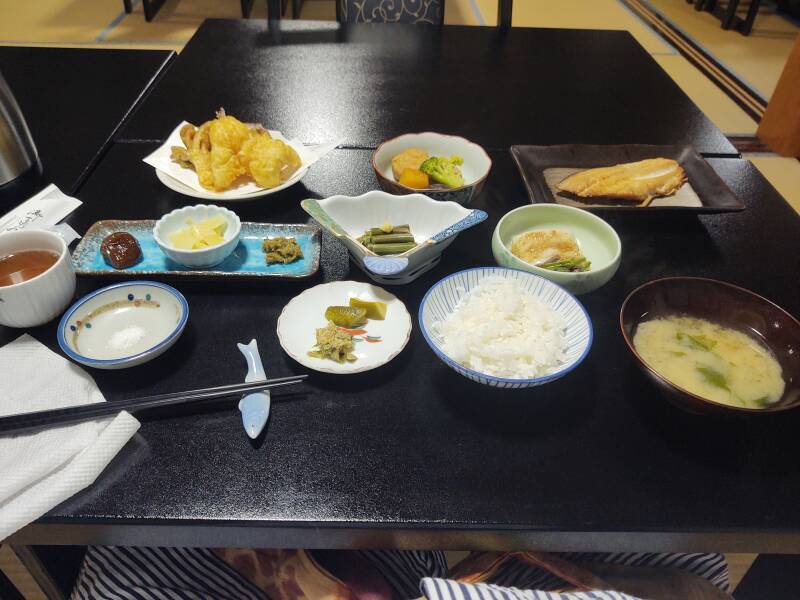
Chopsticks are hashi, a chopstick rest is a hashioki.
As for the miso soup, you pick up the bowl and drink from it.
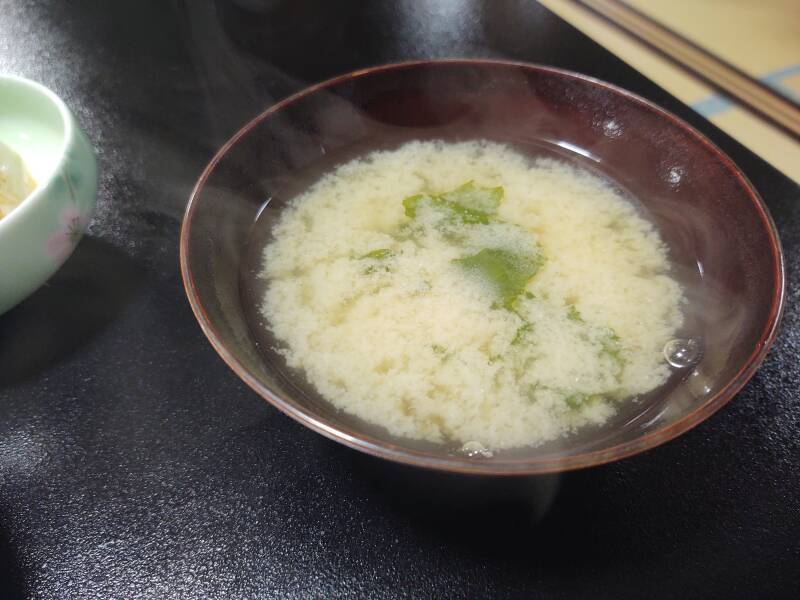
Miso with a sesame seed sauce, and vegetables.

Bamboo shoots, steamed and pickled vegetables, and mushroom with fish cake.
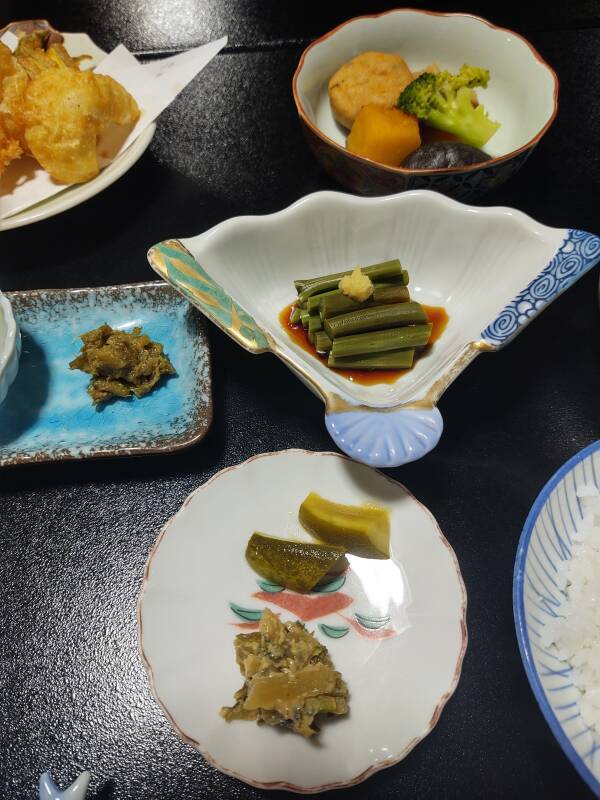
Bamboo and vegetables on a beautiful dish.
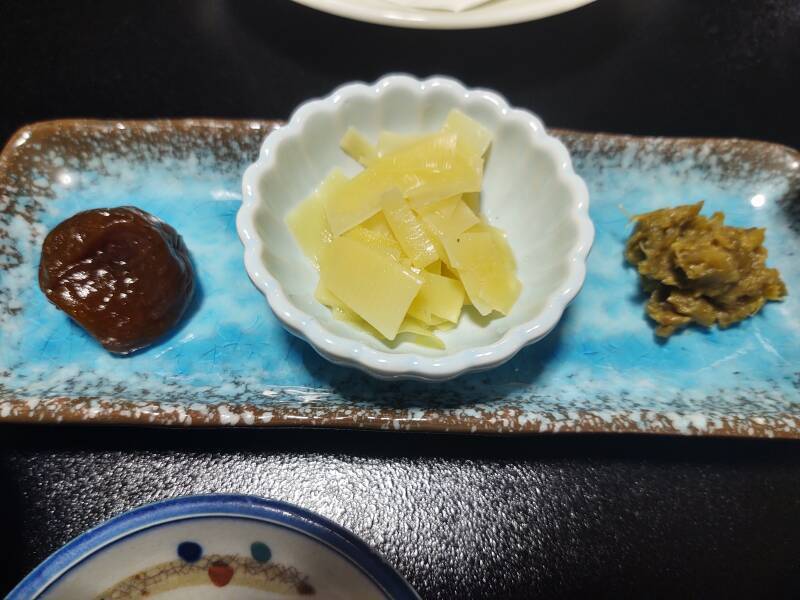
Tempura vegetables.

Grilled fish.

Dinner on Day Three
This would be my last evening at the ryokan.
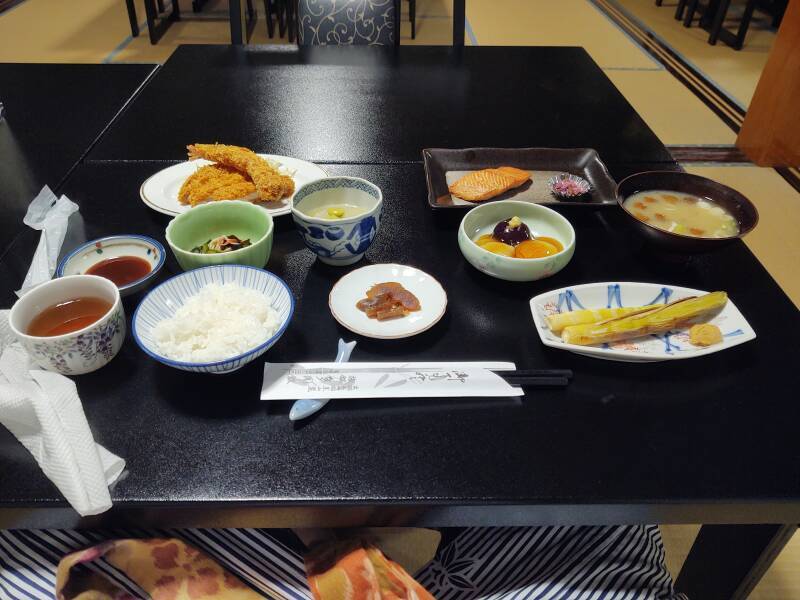
Miso soup with mushrooms and thinly sliced green onion.
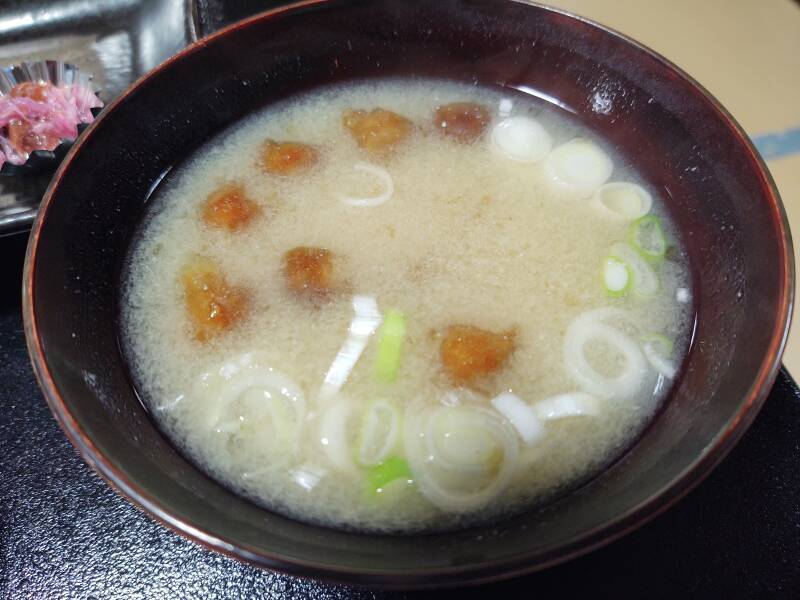
Grilled bamboo.

Grilled salmon and pickled vegetables.
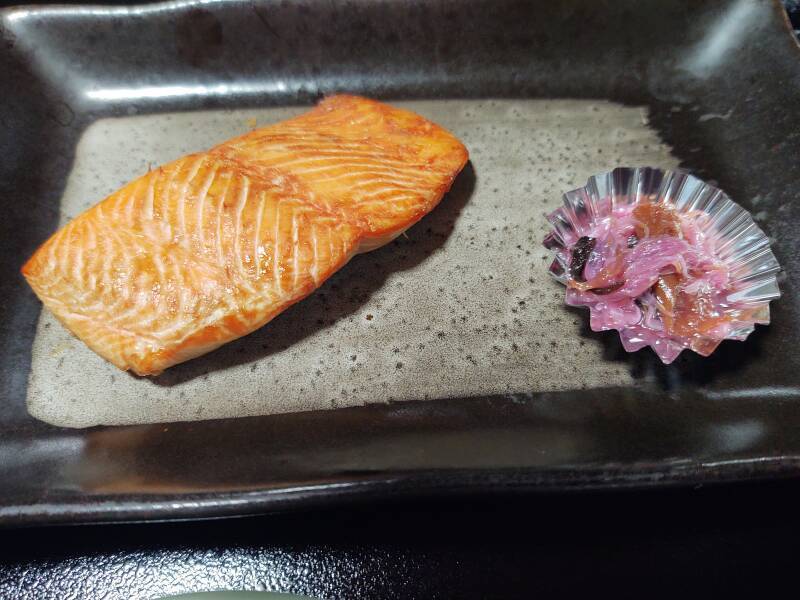
Chicken katsu is made with panko crumbs.
Panko is the combination of two Japanese words, pan meaning "bread" (from the Portuguese pão, as Jesuit missionaries brought bread-baking to Japan) and -ko meaning "flour" or "powder". Panko is made from bread baked in an electrical oven, forming no crust, then ground to thin slivers. It results in a crispier, airier, lighter breading coating.
Here are three slices of a chicken katsu cutlet along with a shrimp or prawn or crevette or whatever you call these edible aquatic crustaceans. Very edible.
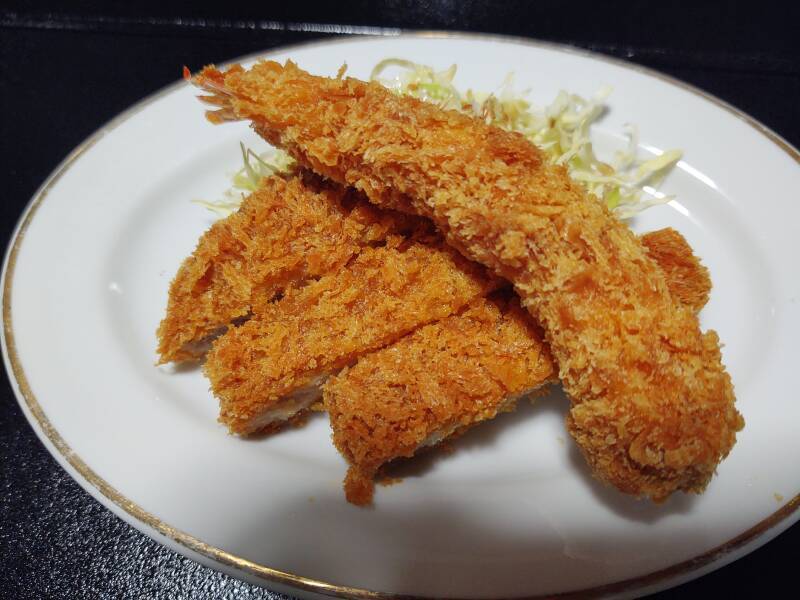
Katsu is usually served with a brown tonkatsu dipping sauce, seen here to the left of more pickled vegetables.
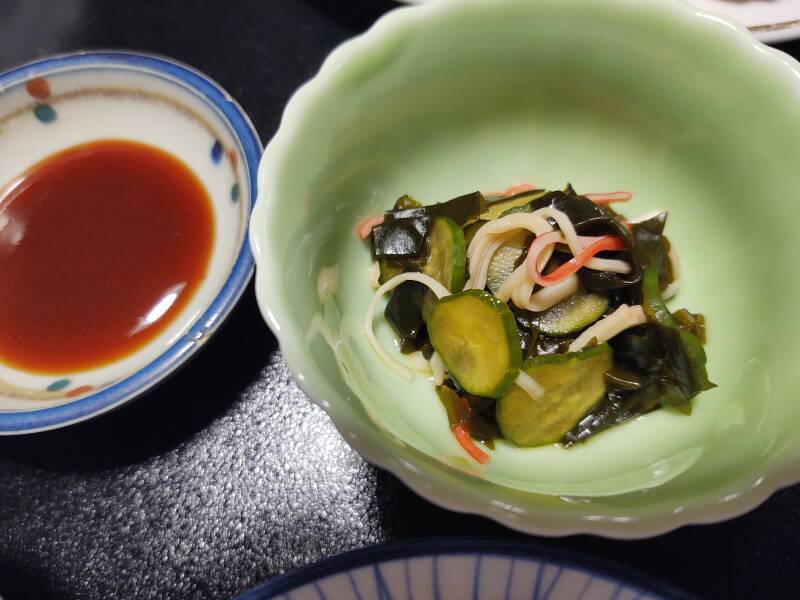
Soybeans and miso at top, pickled mushrooms below.
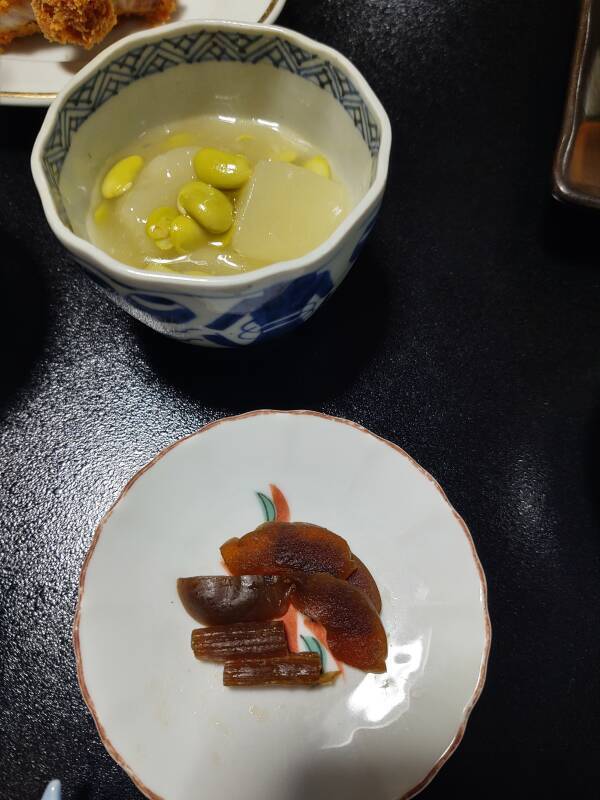
Then a dessert of miso and boiled egg slices covered in honey, along with a candied plum.

What wonderful meals! My room, along with breakfast and dinner every day, cost just ¥ 9,350 per night, equivalent to about US$ 70.
Other topics in Japan:
